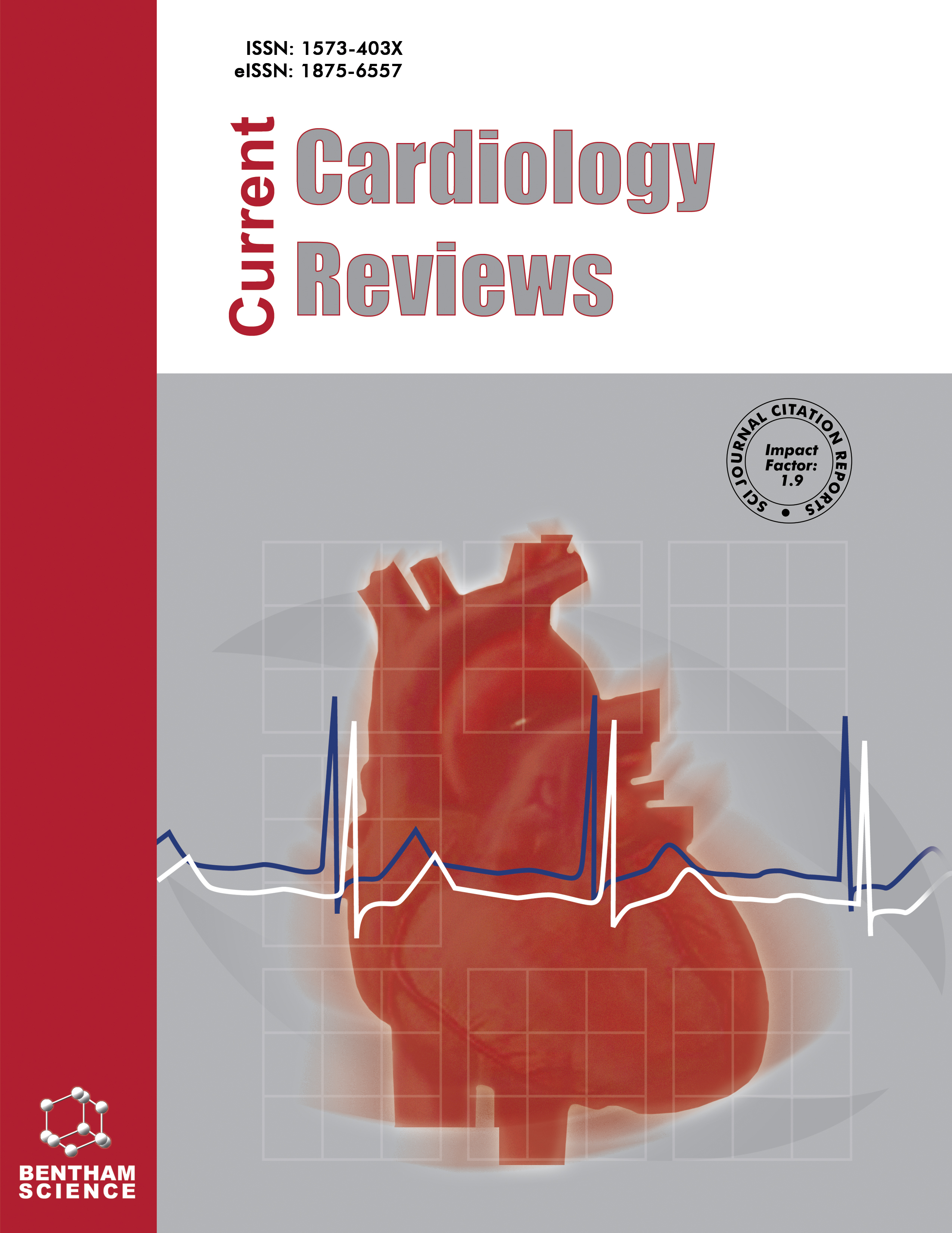- Home
- A-Z Publications
- Current Cardiology Reviews
- Previous Issues
- Volume 19, Issue 5, 2023
Current Cardiology Reviews - Volume 19, Issue 5, 2023
Volume 19, Issue 5, 2023
-
-
Cardiac Multimodality Imaging in Hypertrophic Cardiomyopathy: What to Look for and When to Image
More LessAuthors: Perry Wengrofsky, Yonatan Akivis and Inna BukharovichHypertrophic cardiomyopathy (HCM), now recognized as a common cardiomyopathy of complex genomics and pathophysiology, is defined by the presence of left ventricular hypertrophy of various morphologies and severity, significant hemodynamic consequences, and diverse phenotypic, both structural and clinical, profiles. Advancements in cardiac multimodality imaging, including echocardiography, cardiac magnetic res Read More
-
-
-
Galectin-3 and HFpEF: Clarifying an Emerging Relationship
More LessAuthors: Basil M. Baccouche and Emmajane RhodenhiserIntroduction: HFpEF is one of the leading causes of death whose burden is estimated to expand in the coming decades. This paper examines the relationship between circulating levels of galectin-3, an emerging risk factor for cardiovascular disease, and the clinical diagnosis of HFpEF. Methods: The authors reviewed peer-reviewed literature and 18 studies met the inclusion criteria. Study characteristics, study outcome Read More
-
-
-
Temporary Mechanical Circulatory Support: Left, Right, and Biventricular Devices
More LessAuthors: Michael Dangl, Michael Albosta, Hoda Butros and Matthias LoebeTemporary mechanical circulatory support (MCS) encompasses a wide array of invasive devices, which provide short-term hemodynamic support for multiple clinical indications. Although initially developed for the management of cardiogenic shock, indications for MCS have expanded to include prophylactic insertion prior to high-risk percutaneous coronary intervention, treatment of acute circulatory failure following cardi Read More
-
-
-
Leadless Pacemakers: State of the Art and Selection of the Ideal Candidate
More LessAuthors: Evan A. Blank, Mikhael F. El-Chami and Nanette K. WengerThe field of cardiac pacing has been defined by constant development to provide efficacious, safe, and reliable therapy. Traditional pacing utilizes transvenous leads, which dwell in the venous system and place patients at risk for complications, including pneumothorax, bleeding, infection, vascular obstruction, and valvular compromise. Leadless pacemakers have been developed to overcome many of the challenges of tran Read More
-
-
-
Regulation of HIF-1 by MicroRNAs in Various Cardiovascular Diseases
More LessAuthors: Vahideh Tarhriz, Leila Abkhooie and Mostafa Moradi SarabiToday, we see an increase in death due to cardiovascular diseases all over the world, which has a lot to do with the regulation of oxygen homeostasis. Also, hypoxia-inducing factor 1 (HIF-1) is considered a vital factor in hypoxia and its physiological and pathological changes. HIF- 1 is involved in cellular activities, including proliferation, differentiation, and cell death in endothelial cells (ECs) and cardiomyocytes. Similar t Read More
-
-
-
Countermeasures for Maintaining Cardiovascular Health in Space Missions
More LessAuthors: Jhilam Pramanik, Akash Kumar, Lakshay Panchal and Bhupendra PrajapatiDuring space exploration, the human body is subjected to altered atmospheric environments and gravity, exposure to radiation, sleep disturbance, and mental pressures; all these factors are responsible for cardiovascular diseases. Under microgravity, the physiological changes related to cardiovascular diseases are the cephalic fluid shift, dramatic reduction in central venous pressure, changes in blood rheology and endot Read More
-
-
-
Coronary Artery Aneurysms as a Cause of Acute Coronary Syndrome Presentation - A Focused Review
More LessAuthors: Azka Latif, Amy Tran, Junaid Ahsan, Noman Lateef, Waiel Abusina, Vikas Kapoor, Zoraiz Ahsan, Soban Ahmad and Mohsin MirzaCoronary artery aneurysms (CAA) are defined as a dilation of a coronary vessel greater than 1.5 times the diameter of a local reference vessel. While CAAs tend to be incidental findings on imaging, they result in complications, such as thrombosis, embolization, ischemia, arrhythmias, and heart failure. Among symptomatic cases, chest pain has been the most common manifestation of CAAs. This necessitates an understan Read More
-
-
-
Pseudocoarctation of the Arch and the Abdominal Aorta: A Review
More LessAuthors: Manjappa Mahadevappa, Prashanth Kulkarni, Lakshay Attri and Nidhi BasavarajPseudocoarctaion of the aorta is a rare congenital anomaly occurring in isolation or with other congenital heart diseases. The anatomical basis of the condition is linked to an elongated, redundant aorta which may affect the arch, or the abdominal aorta rarely giving rise to kink and buckling without causing any significant functional stenosis. It should be carefully differentiated from the common true coarctation of the aorta. Read More
-
-
-
Clinical and Structural Factors Affecting Ablation Outcomes in Atrial Fibrillation Patients - A Review
More LessAuthors: Justin Brilliant, Ritu Yadav, Tauseef Akhtar, Hugh Calkins, Natalia Trayanova and David SpraggCatheter ablation is an effective and durable treatment option for patients with atrial fibrillation (AF). Ablation outcomes vary widely, with optimal results in patients with paroxysmal AF and diminishing results in patients with persistent or long-standing persistent AF. A number of clinical factors including obesity, hypertension, diabetes, obstructive sleep apnea, and alcohol use contribute to AF recurrence following ablation, likely t Read More
-
-
-
Expert Consensus on Ivabradine-based Therapy for Heart Rate Management in Chronic Coronary Syndrome and Heart Failure with Reduced Ejection Fraction in India
More LessHeart rate is an important indicator of health and disease and the modulation of heart rate can help to improve cardiovascular outcomes. Besides β-blockers, Ivabradine is a wellestablished heart rate modulating drug that reduces heart rate without any hemodynamic effects. This consensus document was developed with the help of expert opinions from cardiologists across India on effective heart rate management in routine Read More
-
Volumes & issues
-
Volume 21 (2025)
-
Volume 20 (2024)
-
Volume 19 (2023)
-
Volume 18 (2022)
-
Volume 17 (2021)
-
Volume 16 (2020)
-
Volume 15 (2019)
-
Volume 14 (2018)
-
Volume 13 (2017)
-
Volume 12 (2016)
-
Volume 11 (2015)
-
Volume 10 (2014)
-
Volume 9 (2013)
-
Volume 8 (2012)
-
Volume 7 (2011)
-
Volume 6 (2010)
-
Volume 5 (2009)
-
Volume 4 (2008)
-
Volume 3 (2007)
-
Volume 2 (2006)
-
Volume 1 (2005)
Most Read This Month
Article
content/journals/ccr
Journal
10
5
false
en


